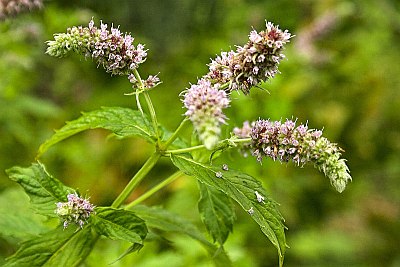History of Mint – Folklore & Medicine
(Mentha viridis, Linn.)

Spearmint has been cultivated for so long, that some believe it would be virtually impossible to find it growing in its original form in nature. Biblical references to mint suggest it was of such high value as to be used as tithes by the Pharisees along with anise and cumin. (Matthew xxiii, 23)
Mint history is colored by stories from ancient mythology. Proserpine, Pluto’s wife, was said to have transformed a hated rival into the mint plant. Both the Latin, Metha, and the Greek, Minthe, have come to be associated with metamorphosed beauty.
In Ancient Athens, where it was common to scent different parts of the body with different herbs, mint was the scent most commonly used on the arms.
Mint history has it being introduced to England by the Romans and is mentioned by John Gardiner before 1440 as ‘myntys’. John Gardiner may have been a pseudonym and little is known about him. He published Feate of Gardening in 1440 but it may have been written much earlier. Feate is perhaps the earliest horticultural work in the English language and was written in verse.
In the 14th Century we found early versions of toothpaste. It was used during that time for whitening teeth.
Turner (1508 – 1568), who was known as the Father of British Botany, believed it was good for ‘ye stomack’ and is pleasant in sauces.
Culpepper (1616 – 1654), a physician-astrologer who fought in his country’s Civil War, suggests that mint should never be given to a wounded man because it will prevent his wound from healing. He used mint to treat almost 40 different ailments.
We also found reference in our research on mint history to a superstition that mint should never be cut with iron. No explanation was given as to why this was a bad thing.
In the 17th Century, John Gerarde described mint as having a “smelle rejoyceth the heart of man.”
Mint history identifies the Pilgrims as the people most likely responsible for bringing the herb to the New World according to John Josselyn. Josselyn, a 17th century English traveler, chronicled his visit to New England and included information on many of the plants of that colony.
This species of mint is also known as “Mackerel Mint” and in Germany it was called “Lady’s Mint” with a pun on the word munze, a word meaning a building or institution where coins are produced. The name, spear or spire, refers to the spiry form of its floral blossoming. Spearmint was once macerated and added to milk because it appeared to lengthen the shelf-life of milk and keep it from curdling (remember this is pre-refrigeration days). It was also recommended for use by people with delicate constitutions or young children with ‘feeble digestive powers’. It was however, not recommended for use when a fever was present. (again, no reason was given for this exception) Spearmint oil is less used than it’s stronger cousin, peppermint. The mint sauces and jellies that usually accompany lamb dishes are made of the milder-flavored spearmint. It was once recommended as a treatment for hiccough, flatulence as well as ‘the giddiness of indigestion’. Used externally, oil of spearmint, was thought to heal ‘chaps and indolent eruptions.’ Lovely photograph of a mint in full bloom thanks to the generosity of the photographer Martin Kozak who released this work into the public domain. Our Herb Garden also has guides on Growing mint and Mint Companion Planting. Be sure to check out our great mint punch recipe.
Additional Mint Information.
